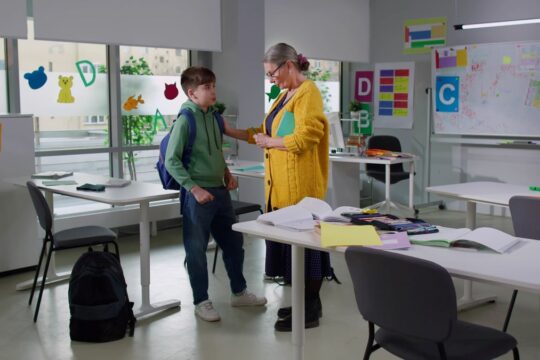Did you know that about 19.2% of students ages 12-18 experience bullying during the school year? While that number is staggering, it’s the reality many students face daily.
Bullying has been a longstanding issue in schools, and with the rise of technology, cyberbullying has added another layer to the challenge. It seems like every time you turn on the news, there’s another heartbreaking story about bullying and its impact.
With increasing concerns about school violence, many teachers find themselves questioning: When is the right time to intervene? The short answer? Immediately.
Whether it’s in the classroom, online, or in the hallways, teachers play a crucial role in stopping bullying before it escalates. Here’s a guide to when and how to step in to ensure student safety.
How to Intervene
As a teacher, it’s crucial to intervene whenever you witness misconduct between students. Immediate action sends a clear message: bullying and aggressive behavior are unacceptable.
According to a National Education Association (NEA) survey, 98% of school staff believe it’s their responsibility to step in when they observe bullying. Research also indicates that consistent intervention can reduce bullying behavior over time. While school policies may vary, there are universal steps educators can take to protect students.
Laying the Groundwork for Bullying Intervention
Preparation is key to handling school bullying effectively. Here’s what you can do to set yourself up for success.
Know Your Rights and School Policies
While stepping in feels like the right thing to do, intervention must align with your school’s policies. Check with your district’s legal counsel or administration to understand your rights and responsibilities. This ensures that when you do intervene, you’re acting within legal guidelines.
Get Trained in Bullying Prevention
All faculty members should receive training on intervention techniques for bullying in schools, including de-escalation strategies, verbal intervention, and emergency response. If you haven’t been trained, ask your administrator about available workshops or resources.
Be Ready to Make Referrals
Stopping bullying at the moment is critical, but follow-up support is just as important. School counselors, psychologists, and social workers play a key role in helping both the bullied student and the bully. Have a list of resources on hand so you can connect students with the support they need.
What to Do During a Bullying Incident
When bullying happens, your response needs to be immediate, calm, and clear. Here’s how to take action.
1. Stop the Situation Immediately
If you witness bullying, step in right away. Separate the students involved and ensure the situation is under control. The longer bullying continues, the more damage it causes.
2. Ensure Everyone’s Safety
If necessary, seek medical assistance or alert security personnel. If weapons are involved, follow your school’s emergency procedures, including notifying law enforcement.
3. Give a Clear, Firm Message
In a calm but authoritative tone, let students know that bullying is unacceptable. The student engaging in bullying behavior needs to hear that their actions are wrong, while the bullied student needs to know they are safe and supported. A simple, direct statement like, “That’s not okay. We don’t treat people that way,” can shut down the behavior on the spot.
4. Address Bystanders
Recognize students who spoke up and encourage those who didn’t to take action next time. Bystanders play a powerful role in stopping bullying, so reinforcing positive behavior can make a difference.
5. Plan for a Follow-Up
Tell all the students involved that this situation isn’t over yet—there will be a follow-up discussion. This ensures that bullying is properly addressed rather than ignored after the initial intervention. Check-in with the student who was targeted to ensure they feel safe and supported. If necessary, involve a counselor to provide additional help.
What to Do After a Bullying Incident
Intervening in the moment is just one step—the real work happens in the follow-up. Here’s how to ensure bullying doesn’t continue.
1. Conduct a Thorough Follow-Up
Document everything. Gather statements from all parties involved, including witnesses, and follow the school protocol for reporting bullying incidents. The more detailed your records are, the better.
2. Support the Bullied Student
Check-in with the student who was targeted. Offer counseling, peer support groups, or mentoring programs to help them regain confidence. Let them know they have a safe space in your classroom.
3. Impose Consequences for the Bully
If you have the authority to enforce consequences, do so immediately. Bullying should have clear, consistent repercussions that focus on accountability and behavior change, not just punishment. This might include restorative justice practices, counseling, or a letter of apology.
4. Monitor the Situation Moving Forward
Bullying often continues after the initial incident, sometimes in subtler ways. Keep an eye on interactions between students and follow up regularly to ensure the problem doesn’t persist.
Preventing Bullying Before It Starts
While stepping in when bullying happens is crucial, creating a classroom culture that discourages bullying from the start is even more powerful. Here’s how you can proactively reduce bullying in your classroom.
Set a Clear No-Bullying Policy
From day one, establish firm expectations about kindness, respect, and inclusion. Reinforce these values daily through classroom discussions and activities.
Model Respect and Empathy
Students learn by example. Treat every student with respect and handle conflicts in a calm, solution-focused manner.
Encourage Open Communication
Make sure students know they can come to you if they’re bullied. Let them know you’ll listen without judgment and take their concerns seriously.
Teach Bystanders How to Take Action
Many students want to help but don’t know how. Teach them strategies for safely standing up for others, such as speaking up or reporting bullying to an adult.
Create an Inclusive Environment
Celebrate diversity and make every student feel valued and included. When students respect each other’s differences, bullying is less likely to occur.
Bullying is a serious issue, but teachers have the power to stop it in its tracks. The key is to intervene immediately, follow up effectively, and create a culture of respect and inclusion.
Be the teacher who takes action. Because for the student being bullied, knowing they have a trusted adult in their corner can change everything.
Educators never stop learning; check out our available graduate degree programs to hone your skills and promote lifelong learning and academic excellence.




